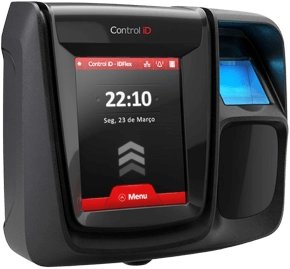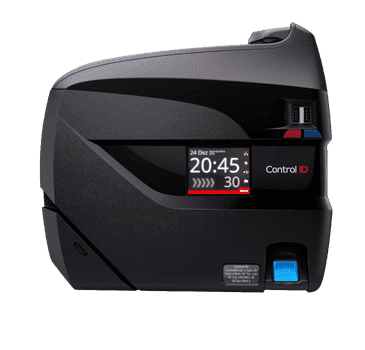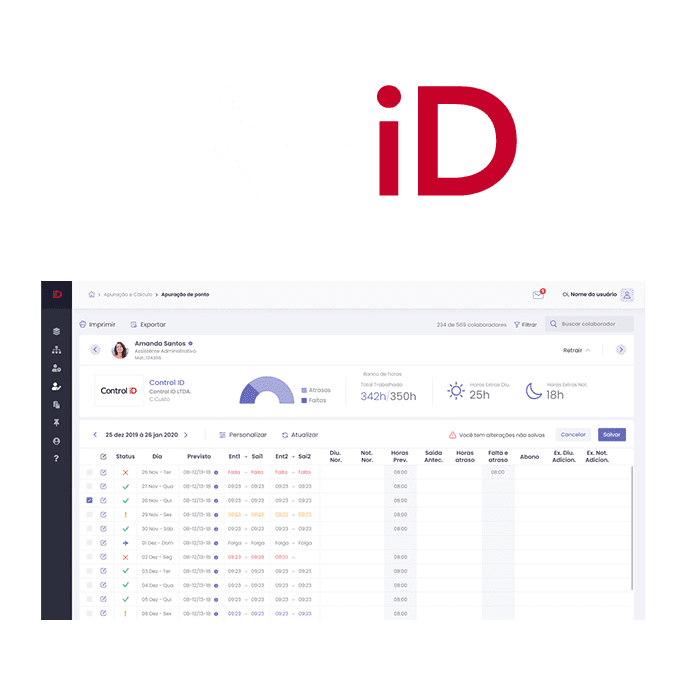Time Attendance
The Electronic Attendance Recorder (REP), also called a digital time attendance device, is an equipment used to control employee work hours automatically during the contract.
This monitoring process is performed by the Time Attendance device recording when the employee enters and exits the company. Also, the device can also print and issue tax receipts for the employee's personal control and records the data obtained in the memory for occasional inspections.
Currently, the Brazilian labor legislation requires the electronic time attendance device to be certified by the Ministry of Labor and Employment (MTE), according to Ordinance 1510/2009 and Ordinance 373/2011. In addition, it must be certified by the National Institute of Metrology, Quality and Technology (Inmetro), proving that it complies with the legal requirements.
In this context, Control iD provides certified Electronic Time Attendance Devices with biometric identification options, RFID (Radio Frequency Identification), or through an attendance chart with a bar code or personal password.
Learn about our digital time attendance solutions, equipped with state-of-the-art identification technology and attendance control software.
Frequently Asked Questions
-
How does a digital time attendance device work?
The digital time attendance device was created to make the workday control more agile and reliable, replacing the cartographic attendance devices. However, the operation is basically the same, except for the fact that the digital device provides greater versatility and safety.
Thus, at the beginning and end of the shift, as well as during work breaks, the employee registers his presence in the electronic attendance device using a password, biometric identification or badges and personal cards.
The time attendance device stores the schedules when employees entered the company in its memory, automatically transferring this data to a workday management software.
At the end of each month, the human resources department can access detailed information about each employee´s attendance in order to calculate any overtime and discounts.
How does the time attendance process take place?
The clock uses one or more authentication technologies to identify which of the pre-registered employees is registering their entrance or exit. After this recognition, the device issues a printed voucher for the worker and adds the exact schedule to the complete list of registries made by the employee.
Thus, the attendance control system has information concerning employee entry, exit and break schedules, as well as calculating the hours worked daily. By storing all of the attendance data, the system can determine monthly and yearly totals, as well as generate digital attendance reports.
What are the identification technologies used in the time attendance device?
Technologies and tools vary according to each device model, but the base concept is being able to customize attendance records and authenticate employees as they register their attendance. The most commonly used features for Time Attendance devices in the market are:
biometric fingerprint identification;
RFID card, bracelet or other magnetic device;
bar code reader with a personal identification card;
personal password entered in the system.
All of these identification tools are available in Control iD products, developed with their own technology, and can be chosen according to the time access device model.
How can employees know if a process worked out?
A time attendance device certified according to ordinance 1510/2009 of the MTE, such as the iDClass REP Time Attendance Device by Control iD, is equipped with a printer that issues a voucher for the employee whenever they register their entrance or exit.
The equipment produced according to MTE Ordinance 373/2011, called alternative work control systems, usually do not print vouchers. However, because they automatically store all the data in real time, the worker can check it by logging on to the system or by requesting a report from the human resources department.
How can this information be accessed?
Each registry on the time attendance device is recorded in the machine's memory and instantly sent to the management software. Thus, the information can be accessed at any time from any previously authorized device connected to that system.
Because of this, the digital time clock enables discreet monitoring of employees according to each manager´s needs. In addition, it eliminates the need for generating reports or calculating the total amount of hours worked each month and year, since everything is done automatically.
-
Why use a digital time attendance device?
The digital time attendance device assists the human resources department in an organization, helping them to manage work hours. The system makes checking employees' schedules more reliable, accurate and transparent, reducing the possibility of human failures and conflicts, and avoiding fraud and losses.
What kinds of losses are these?
Adopting a time attendance control solution that automates and makes the work schedule records more objective is essential if a company or organization - regardless of its size and industry - desires to avoid losses in work processes and team management.
After all, lawsuit costs are not limited to compensations and claims. There are also court costs and attorney fees, as well as travel expenses and downtime. If we take a deeper look, one must also account for the corporate image losses among society.
On the other hand, a team that is not satisfied with their salaries or how their work hours are calculated tends to have a drop in productivity and efficiency.
What are the advantages for the electronic time attendance device?
The digital time attendance device makes part of the monitoring and management of employees automated, making work hour control safer. Thus, the time and resources used to control attendance and the monthly and annual calculations for salaries, holidays and bonuses are reduced.
Moreover, using a digital time attendance device, especially if it has a biometric reader, for attendance records, reduces the fraud possibilities. In addition, it minimizes the occurrence of human errors when compiling the information and performing compensation calculations.
Finally, the use of electronic time attendance machines avoids excessive lawsuits and provides greater efficiency for human resource management in the organization.
-
What are the existing time attendance machines?
Basically, what differentiates the types electronic time attendance machines is the employee identification technology that each model offers. Through these resources, the equipment registers attendance and assigns this data to the correct records, helping to speed up the registration processes for work hours and reduce fraud.
Until recently, each employee received a monthly paper card that was punched when inserted into the machine. The holes marked the entry and exit schedules. These were called cartographic time attendance machines.
The information was only recorded on these cards. Therefore, those responsible for human resources had to collect them monthly and manually calculate salaries.
Although cartographic time attendance machines still exist, new technologies have created alternatives for more efficient and less expensive attendance control. The most modern examples include:
Biometric Time Attendance Machine: uses biometric recognition technology, through fingerprint analysis, to identify the employee. It is the most modern and safe method, since it makes fraud difficult and assures that attendance will only be registered by the actual employee;
Attendance control with bar code identification: unlike the cartographic time attendance machines, these devices read the bar code on a personal, non-transferable plastic card. Whenever the card goes through the equipment, the digital time attendance machine registers the schedule on the employee's chart;
RFID Digital Time Attendance Machine: Radio frequency identification (RFID) is done by bringing the card or other magnetic device - also personal and non-transferable for each employee - close to the time attendance device. The device then recognizes the ownership of the device and assigns the schedule to the related employee. It is the same technology present in modern public transport tickets, for example;
Time attendance machine with a password: when hired, the employee registers a password in to the electronic time attendance system and type it in, when entering and exiting the company, recording the schedules.
It is important to highlight that digital time attendance equipment does not need to only have one type of identification feature. Control iD, for example, provides models that use all of the aforementioned technologies, being easily adaptable to each client's needs for work hour control among employees.
-
Why is the biometric time attendance device the right one?
There are two main differentials when considering biometric time attendance devices and other models: safety and practicality. Check it out!
Safety!
The biometric time attendance machine validates the schedule data for an employee by reading their fingerprint. Since each fingerprint is unique, it is possible to control the employee work schedules with greater precision and confidence.
Since the methods for fraud in biometric fingerprint reading are often expensive and ineffective, they become less interesting. In addition, employees themselves feel more secure knowing that only they can register their work hours.
Praticality!
With a biometric time attendance machine the employee does not have to carry an attendance card or remember a password. On the other hand, the human resources sector does not need to maintain strict supervision on schedule registrations, since employees must be present in order to register schedules.
Want to know more about the advantages of biometrics for controlling working hours? Then enjoy reading our article on the top reasons to use a biometric time attendance machine!
-
What are the laws concerning digital time attendance machines?
Ordinance 1510/2009, also known as the Electronic Time Attendance Device Law, was instituted by the Ministry of Labor and Employment (MTE) to regulate electronic time attendance control devices in Brazil. This ordinance establishes the requirements for every machine operated in the national territory.
Subsequently, the MTE published Ordinance 373/2011, which establishes the parameters for the use of alternative work hour control systems. This law made some rules for the use of time attendance equipment more flexible, considering that there ia a prior agreement with a union or collective convention, making it possible to simplify the equipment and reduce prices.
What is an electronic time attendance device and why should it be certified?
The certification of an electronic time attendance machine, by the Ministry of Labor and Employment, proves that the equipment meets the requirements determined by Ordinance 1510/2009. Therefore, the digital time attendance model must first be analyzed by Inmetro, the agency responsible for issuing the necessary certification for the MTE to approve its commercialization.
Therefore, it is essential for a company to acquire an electronic time attendance device that presents the Inmetro certification and has already been certified by the MTE. These are the only guarantees that the records collected by the equipment will be considered legally valid.
What kind of company can use the digital time attendance machine?
The Brazilian labor legislation only requires organizations with more than 10 employees to control entry and exit schedules. However, the electronic time attendance device can benefit any company - large, medium or small - and any type of activity, increasing security against lawsuits and conflicts among employees.
-
What is the difference between the digital time attendance machine and the cartographic time attendance machine?
The difference between the digital time attendance device and the cartographic device is the system operation, that is, how the equipment will be used and how the data collected will be verified.
How do the cartographic and digital time attendance devices operate?
The cartographic time attendance device requires each employee to carry a card where the schedules are registered graphically. While the electronic time attendance device uses a digital system to store and manage work hours.
What changes from one system to another?
-
Practicality and efficiency
The cartographic time attendance machine requires manual calculations of working days and the related salaries, analyzing cards individually. The digital time attendance device makes all the records and generates reports instantly and automatically, as well as enabling access to the data from any device connected to the system.
-
Security
Unlike the digital time attendance machine, the cartographic machine does not use identification tools. Schedule differentiation takes place exclusively on the cards. Thus, the system can be circumvented with a simple exchange of cards between employees. In addition, errors in attendance registrations on the Cartographic model can not be corrected with system adjustments, such as in the electronic time attendance device.
-
-
What is the difference between a digital attendance controller and a digital time attendance machine?
The digital time attendance machine is an equipment that controls work hours, registering employee entrances and exits. That is is why it is also called a digital attendance controller, and is also officially known as an electronic attendance recorder (REP), electronic time attendance machine or simply an electronic or digital attendance device.


